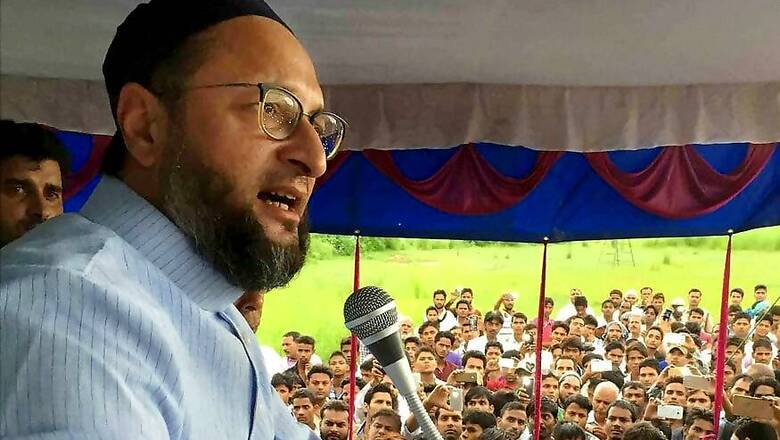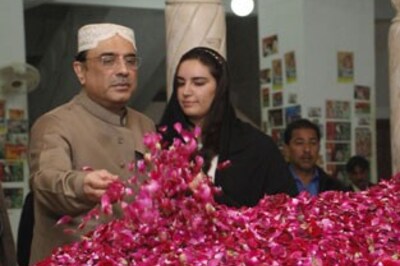
views
Patna: The victory of the All India Majlis-e-Ittehadul Muslimeen (AIMIM) in the Bihar assembly by-elections from Kishanganj has inflicted a severe blow to the secular strain of political parties, which have hitherto been thriving on the preponderant Muslim votes in the Seemanchal region of Bihar.
For the first time, the AIMIM got a foothold in Kishanganj assembly seat when its candidate Qamrul Hoda defeated the ruling Bharatiya Janata Party (BJP) candidate Sweety Singh by a margin of over 19,000 votes and relegated the Congress to the third position.
It reflects upon the current churning among the Muslims in the eastern region of Bihar comprising Kishanganj, Araria, Purnea and Katihar districts, also called Seemanchal due to its proximity with West Bengal, Bangladesh and Nepal. It shows that the Muslims’ disposition in this region towards the mainline secular parties is undergoing a significant change.
The last two elections since 2015 have witnessed growing influence of AIMIM leader Asaduddin Owaisi in this region as the usual claimants of the Muslim votes — the Rashtriya Janata Dal, Janata Dal (U) and the Congress — have gradually been losing their strength and credibility among the minority community.
The death of towering leaders of this region like Maulana Asrarul Haque Qasmi and former Union minister Muhammad Taslimuddin has created a void that the RJD and Congress are unable to fill, leaving the Muslim politics in disarray. The young politicians lack experience and are guided more by their respective parties’ leaders than evolving on their own.
In the absence of the two tall leaders of the region, firebrand AIMIM leader Asaduddin Owaisi — known for his oratory skills — is trying hard to take up the mantle and lead the Muslim politics in Seemanchal and North Dinajpur district of West Bengal. He has been nourishing this region since 2015 assembly elections when he fielded candidates from six assembly constituencies.
In the 2015 state polls, the AIMIM had contested from Kochadhaman, Kishanganj, Raniganj, Baisi, Amour and Balrampur assembly constituencies for its entry into Bihar via Seemanchal. It made its presence felt in all the six assembly seats with its catchy slogans like “Ab Milega Sabko Insaaf, Badlega Seemanchal Majlise ke Saath (Now everyone will get justice, Seemanchal will change with Majlis)”.
The AIMIM has finally made its electoral debut from Kishanganj now. Enthused by the response, the AIMIM has decided to expand its footprint in Bihar. The party has so far remained confined to Seemanchal but now it has decided to contest on all assembly seats in the 2020 assembly elections.
“The AIMIM can provide a new political equation with the support of the minorities and Dalits in Seemanchal. We will be a force to reckon with in the state after next assembly polls,” claimed Akhtarul Iman, former MLA and party’s state president.
Imaan was earlier associated with the Janata Dal (U) and RJD before becoming the face of AIMIM in Bihar. He had also unsuccessfully contested from Kishanganj in the last Lok Sabha polls. The seat was won by Congress but the AIMIM came third with 26.85 per cent votes of the total votes polled.
The party has plans to focus on Darbhanga, Madhubani, Champaran, Siwan and other Muslim-dominated areas to provide an alternative to the secular parties, especially the RJD-led grand alliance, which stands fractured due to vaulting ambitions of leaders of the allies.
The AIMIM led by Owaisi is attempting to make full use of the situation and emerge as the sole political leader of the minorities. The AIMIM has been trying, especially after the death of Taslimuddin, to unite the four major sub-groups of Muslim community in this region under one umbrella to ensure that the BJP-led NDA does not firm up its roots anymore.
The major sub-groups of Muslims in the region include the Kulhaiyas, the Suryapuris, the Shershahbadis or Bhatias and Paschimas. While the Kulhaiyas and Suryapuris have local roots and are sizeable in number, the Shershahbadis or Bhatias are migrants from neighbouring West Bengal and the Paschimas are settlers from the western districts of Bihar like Champaran, Muzaffarpur and Darbhanga.
The Seemanchal region has been at the centre-stage of Muslim politics and influences Muslim voters in constituencies along the Indo-Nepal border up to West Bengal in the east and Uttar Pradesh in the west. This stretch has high concentration of Muslims varying between 20 per cent and 70 per cent.
In 2014, Akhtarul Imaan, the then JDU candidate, had pulled out of the fray soon after Mukhtar Ansari had withdrawn his candidature from Varanasi in favour of AAP contestant Arvind Kejriwal. The move was aimed at consolidating minority votes to stop BJP’s Narendra Modi from coming to power.
Kishanganj is the only Lok Sabha constituency in the country where Muslims account for nearly 70 per cent of the total population. No Hindu candidate has ever won from this constituency except Lakhan Lal Kapoor, who won as Praja Socialist Party nominee in 1967. The BJP could win the seat only once in 1999 when its candidate Shahnawaz Hussain was elected.
Due to the region’s proximity with Bangladesh, the monolithic Muslim politics has always veered around infiltrators and refugees after the 1971 Bangladesh war. The BJP wants the National Register of Citizens (NRC) to be implemented in Kishanganj, Katihar, Purnea and Araria districts. The issue comes in handy for both the AIMIM and BJP to outwit each other.
Though the region has hitherto been a Congress stronghold, the politics here might change with the AIMIM making its foray into the electoral arena. Not surprisingly then, firebrand BJP leader and Union minister Giriraj Singh dubbed AIMIM’s victory as ‘dangerous’, alleging that it adheres to Jinnah’s ideology.
(The author is a senior journalist. Views expressed are personal.)



















Comments
0 comment